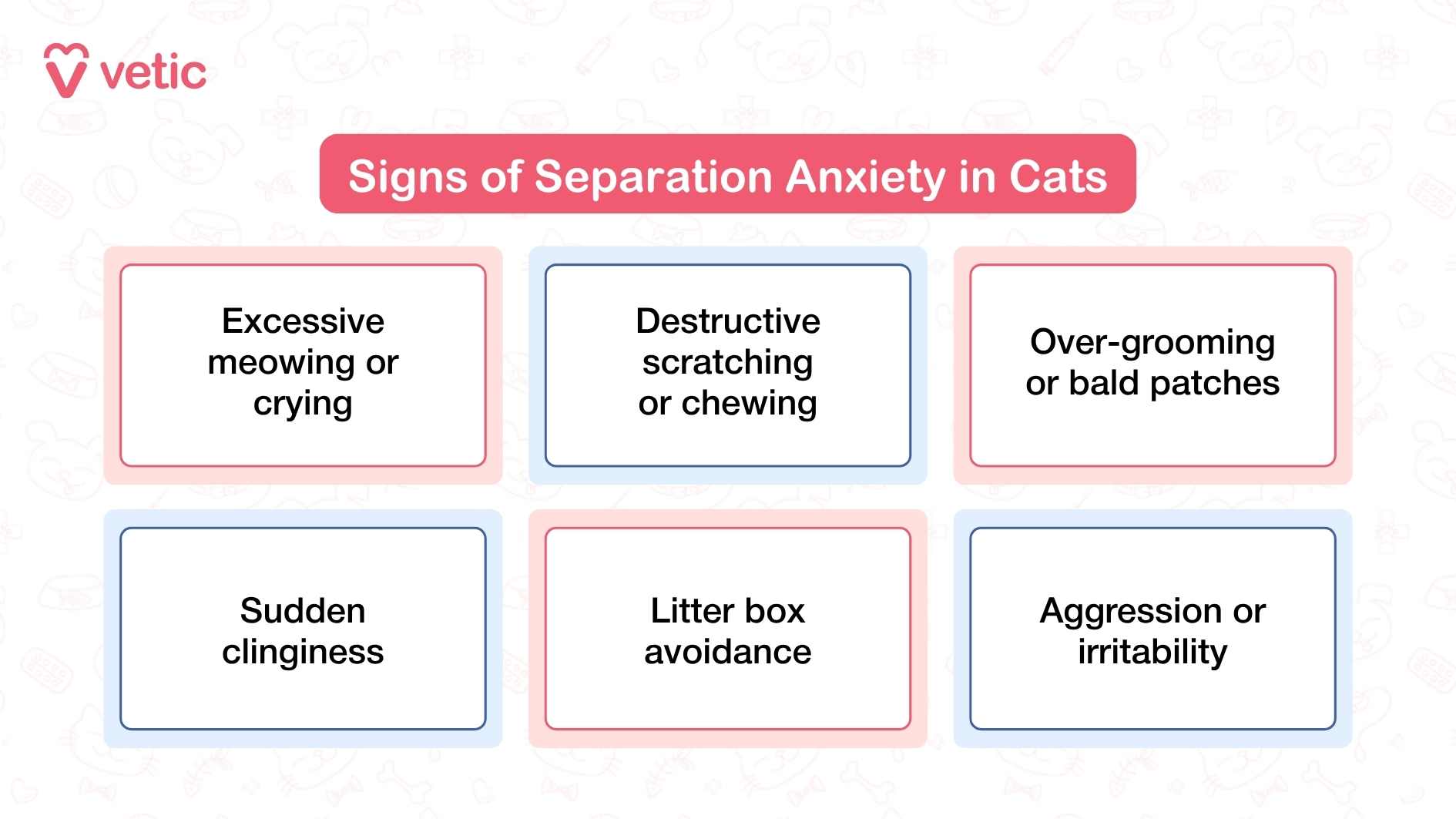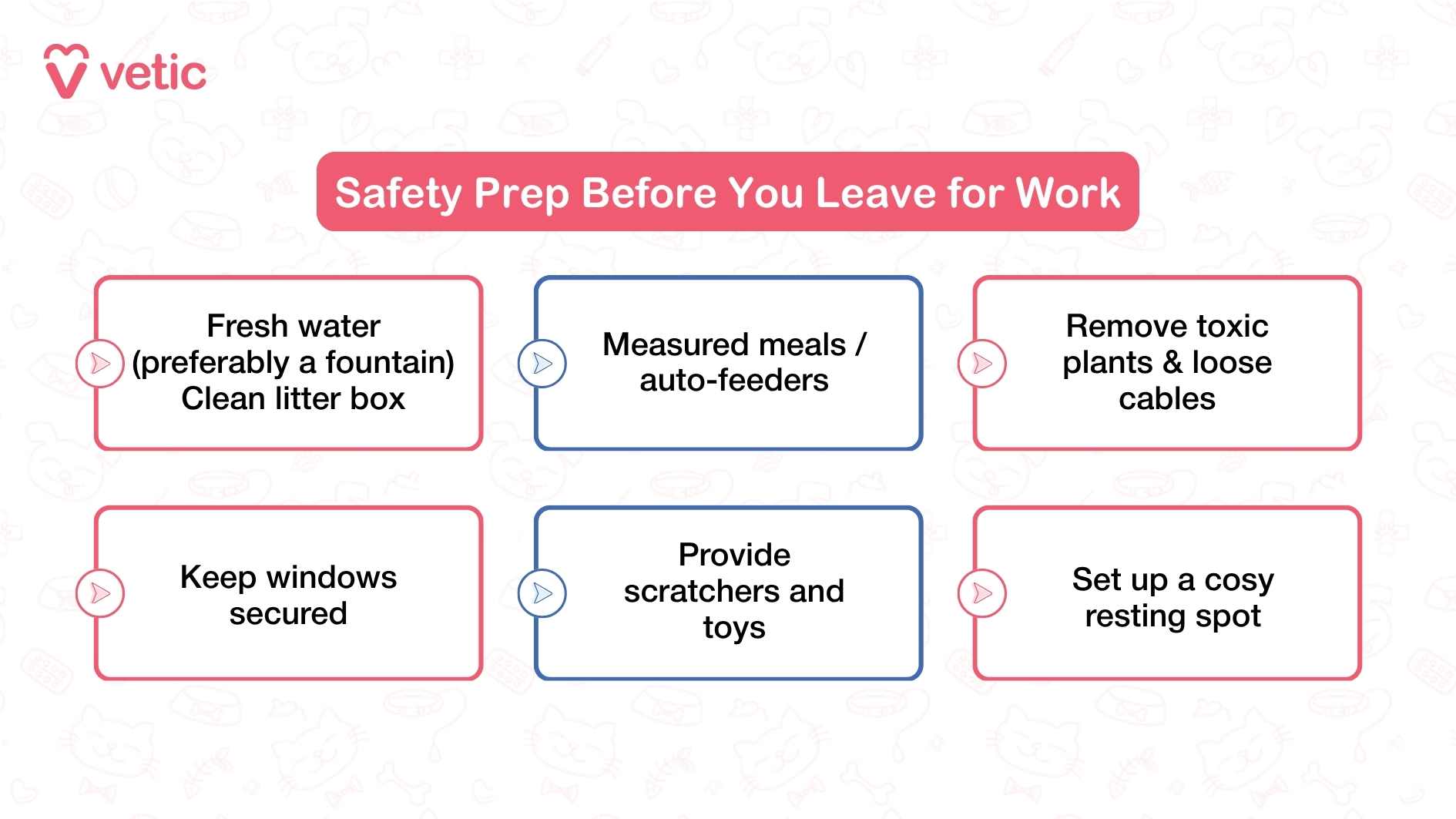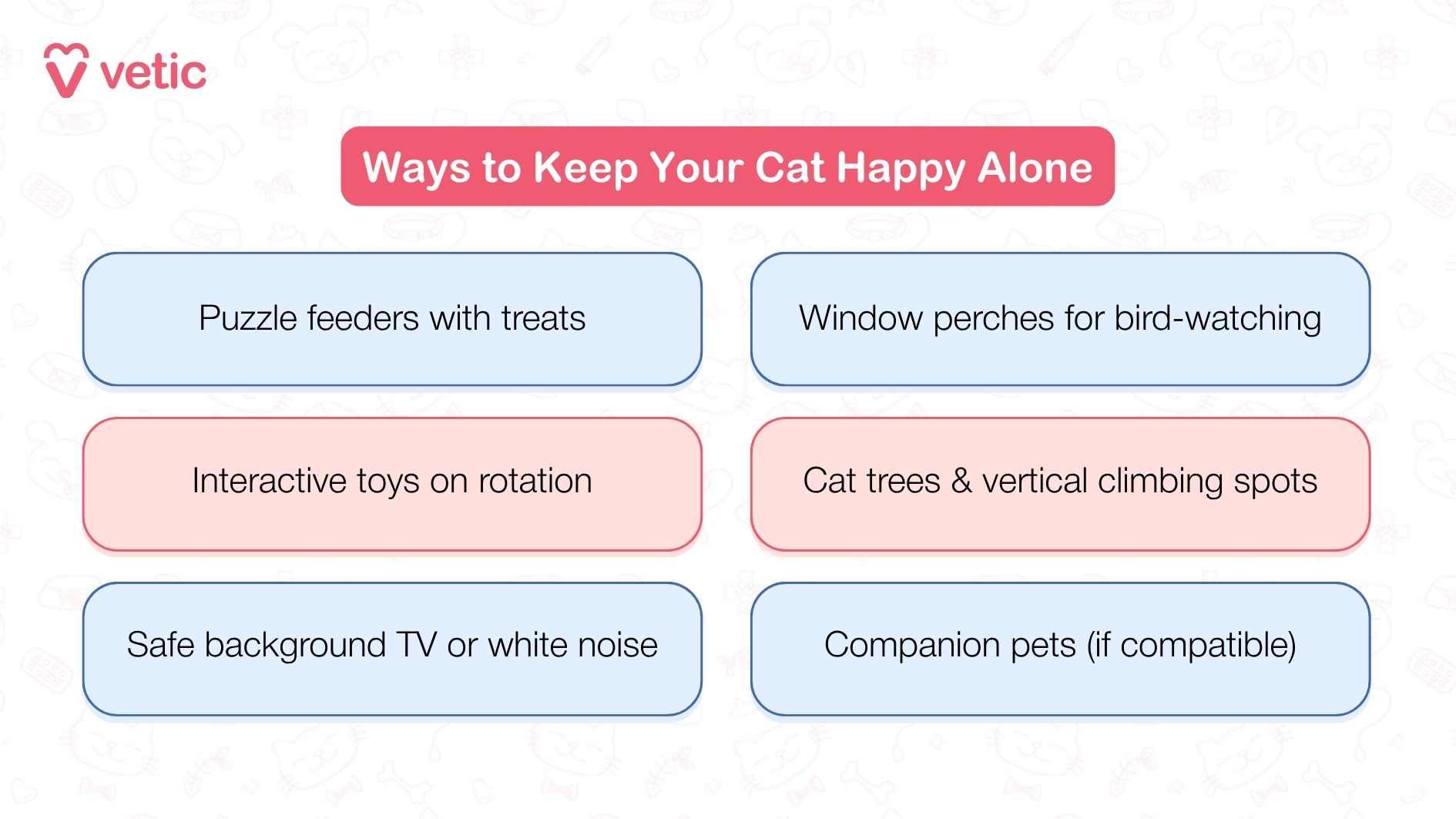Cats are often seen as low-maintenance companions, independent, quiet, and perfectly capable of spending time alone. But as peaceful as that sounds, every pet parent eventually asks the same question: “Is my cat actually okay when I leave them alone at home while I’m at work?”
The truth is somewhere in the middle. Some cats enjoy solitude. Some get anxious. Others fall somewhere in between. What matters is whether your cat’s emotional and physical needs are met while you’re away.
This guide explains how long you can safely leave your cat alone, how to recognize signs of loneliness or stress, and how to create a safe, enriched environment for your kitty, even on the longest workdays.
Cat Behaviour: Is Leaving Your Cat Home Causing Your Kitty Distress?
Cats express discomfort very differently from dogs. Most cats won’t howl or cry; instead, their distress shows up as subtle shifts in behaviour, changes that are easy to miss unless you know what to look for.
A cat may seem “independent,” but silently struggle with boredom, frustration, or loneliness. Others might genuinely enjoy the quiet. Understanding which kind of cat you have is the first step to creating a routine that supports their well-being.
Can I Leave My Cat Alone At Home When I’m Going To Work?
Yes, in most cases, adult cats can handle a standard working day alone without trouble. But safety depends on preparation.
A cat left alone with:
- no stimulation
- insufficient water
- an unclean litter box
- or unsafe access to wires, plants, or open windows
…may experience stress, behavioural issues, or even injury.
What Will Your Cat Need When You Leave Them Alone At Home?
Your cat’s comfort during alone time depends on three essentials: resources, safety, and stimulation.
They must have:
- Fresh water (preferably a fountain)
- Timed or measured meals
- A clean litter box
- Scratchers, toys, and interactive feeders
- High perches or safe hiding spots
- A comfortable resting area
- Safe access to windows (with secure netting)

Understanding Separation Anxiety and Stress in Cats Left Alone
Some cats become stressed even when their physical needs are met. Separation anxiety in cats can be similar to dogs and it often shows up as:
- Excessive meowing
- Over-grooming
- Aggression
- Destructive scratching
- Litter-box avoidance
- Following you around constantly
Cats who develop separation anxiety need additional enrichment, routine, and, in some cases, behavioural support.
Leaving Your Cat Alone: How Long is Okay?
In general:
- Healthy adult cats can stay alone for 8–10 hours (a standard workday).
- Up to 24 hours is usually fine if food, water, and litter are accessible.
- More than 24–48 hours puts them at risk of loneliness, skipped meals, dehydration, and litter-box discomfort.
Recognizing the Difference Between Stress and Relaxation in Cats
A relaxed alone-time cat:
- Sleeps often
- Grooms regularly
- Eats normally
- Remains calm when you return
- Meows excessively
- Scratches furniture
- Over-grooms certain spots
- Acts clingy when you come home
Understanding the difference helps you refine your cat’s routine.
Can You Leave Your Cat Alone For One Whole Day?
You can, but only if their environment is safe and enriched:
- Use automatic feeders to avoid skipped meals
- Keep fresh water flowing
- Ensure litter is clean
- Provide puzzle toys, slow-feeders, and climbing options
- Remove electrical cords and toxic plants
- Ensure windows and balconies are secure
Warning: Free-feeding can lead to overeating and obesity in some cats. Monitor portions or use portion-controlled feeders.
Is Your Cat Feeling Lonely?
Not all cats experience loneliness the same way. While some enjoy quiet time, others depend heavily on human companionship. Look for behavioural clues that suggest emotional distress.
Your cat is grooming themselves excessively
Over-grooming, especially on the belly, legs, or tail, can be a stress response. Some cats use grooming as a coping mechanism when they feel anxious or under-stimulated.
They are being overly clingy
A clingy cat who follows you everywhere, cries when you leave a room, or becomes distressed when you grab your keys may be showing signs of loneliness or separation anxiety.
Your cat is exhibiting aggressive behaviour
Swatting, biting, or sudden irritability can stem from pent-up frustration, boredom, or lack of stimulation.
Your cat isn’t using the litter box
Litter-box avoidance can be linked to stress, loneliness, health issues, or environmental changes. It’s an emotional communication tool for many cats.
Excessive Grooming as a Sign of Stress or Loneliness
When cats groom to the point of thinning fur or bald patches, it’s a sign that their stress levels need immediate attention.
Overly Clingy Behavior and Constant Attention-Seeking
Clinginess is your cat telling you that the alone-time routine isn’t working for them — or that enrichment needs to increase.
Aggressive Behavior Triggered by Loneliness or Frustration
Cats deprived of stimulation may channel pent-up energy into aggression, especially toward people or other pets.
Litter Box Avoidance Linked to Emotional Distress
If your cat suddenly stops using the litter box, loneliness may be contributing — especially if this behaviour aligns with long alone hours.
How Can You Manage or Avoid Loneliness in Cats?
Loneliness is preventable with the right routine and environment.
Here’s what helps most:
- Provide puzzle feeders and slow-feeder toys
- Leave safe TV channels for cats or soft background white noise
- Offer climbing structures like cat trees or wall shelves
- Rotate toys to maintain novelty
- Add hiding spots and cardboard boxes
- Offer window perches to let them watch birds and movement
- Consider a second cat if their personality is compatible
Cat parenting is all about balance — enough engagement to prevent frustration, but enough independence to avoid over-attachment.
How Can You Manage On-and-Off Loneliness in Cats?
Not every cat stays lonely all the time — some experience it inconsistently, depending on their week, environment, or routine.
To smooth the ups and downs:
Providing Entertainment and Mental Stimulation to Keep Your Cat Engaged
Stimulating activities, feather wands, rotating toys, treat puzzles, help maintain engagement and reduce stress.
Creating a Safe and Comfortable Home Environment for Your Cat
Make sure the home is hazard-free: secure cables, hide toxic plants, keep heavy objects off shelves, and ensure windows are cat-proof.
Working From Home With Cats
WFH life can be both wonderful and challenging with a cat. Some cats become overly attached when their humans are always around, leading to anxiety when routines change.
A healthy WFH routine includes:
- Scheduled play sessions
- Independent play time
- Avoiding constant attention
- Maintaining consistent mealtimes
- Teaching your cat to settle alone
Conclusion
Cats are wonderfully independent companions, but they still need preparation, stimulation, and emotional support when left alone. With the right setup — fresh water, clean litter, safe toys, enrichment, and a secure environment — your cat can thrive even on long workdays.
Thoughtful planning ensures your cat stays safe, happy, and emotionally secure, no matter your schedule.
FAQs
1. How long can I safely leave my cat alone while I’m at work?
Most adult cats can stay alone for 8–10 hours if they have food, fresh water, stimulation, and a clean litter box. Longer durations require extra preparation.
2. Can leaving my cat alone cause separation anxiety?
Yes. Some cats develop separation anxiety, shown through excessive meowing, destructive behavior, or over-grooming. Enrichment, routine, and gradual training help reduce stress.
3. What do cats need when left alone during the day?
Your cat needs measured meals, fresh water, a clean litter box, safe toys, scratching posts, hiding spots, and a secure, hazard-free environment to stay comfortable.
4. How can I tell if my cat feels lonely when I’m away?
Signs of loneliness include clinginess, over-grooming, aggression, litter-box avoidance, or vocalizing more than usual. Behavior changes after your return are strong indicators.
5. Is it okay to leave my cat alone overnight?
Leaving a healthy adult cat alone overnight is possible but not ideal. Ensure food, water, and safety checks—or consider a sitter for peace of mind.
6. What age-based limits should I follow when leaving cats alone?
Kittens should be left alone only 2–4 hours. Adult cats can manage a workday. Senior cats and cats with health issues need more frequent supervision.
7. How can I make my cat’s alone-time happier and less stressful?
Offer puzzle feeders, window perches, rotating toys, cat trees, soft background noise, and safe spaces. These reduce boredom and support emotional well-being.




